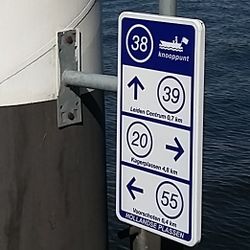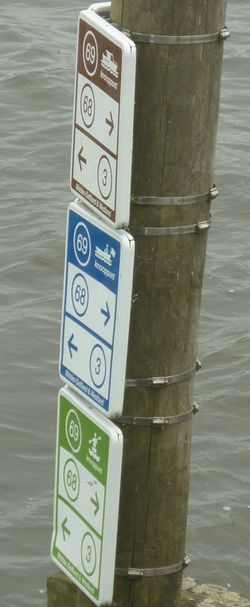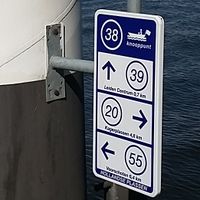Tag:route=motorboat
| Description |
|---|
| Signed recreational motorboat route |
| Group: routes |
| Used on these elements |
| Requires |
| Useful combination |
| Status: in use |
| Tools for this tag |
|
Signed recreational route for motorboat=*. These are routes, like signed canoeing, hiking or cycling routes; not to be confused by a fairway marked with bouys or a navigable non-recrational route for ships and motorboats such as route=waterway or waterway=fairway.
How to map
Motorboat routes are mapped in relations ![]() of type type=route.
of type type=route.
The following characteristics could be included:
- type=route mandatory
- route=motorboat mandatory
- network=* optional
- name=* - Name
- ref=* - Short identifier for route (max 5 characters)
- operator=* - Operator
- distance=* - Distance in km
- roundtrip=yes - Circular route
- description=* - Description of the route
- colour=* - Colour of path symbols, especially when these are distinctive for the route
- symbol=* - Human readable description of the path symbols
- osmc:symbol=* - Machine readable description of the path symbols (used by the maps listed below)
- wiki:symbol=* - filename of symbol in the OSM wiki
Junction network
A junction network consists of numbered junctions of which the numbers are signposted on the routes in between. For more explanation about this method of mapping, see Cycle_routes#Tagging_Cycle_Route_Networks.
The junction number is tagged using the tag rmn_ref=* and network:type=node_network on a node ![]() . This junction is mapped at the actual intersection where the routes meet, not on a signpost next to the road.
. This junction is mapped at the actual intersection where the routes meet, not on a signpost next to the road.
The routes in between the junctions are mapped as relations ![]() of type type=route. All ways in the route are added to the relation, preferably from the lower to the higher junction number. The following tags could be included:
of type type=route. All ways in the route are added to the relation, preferably from the lower to the higher junction number. The following tags could be included:
- type=route mandatory
- route=motorboat mandatory
- network=rmn mandatory
- network:type=node_network mandatory
- ref=* - Numbers of both junctions in ascending order, connected by a dash
All junctions and route relations in a network can be added to a network relation. This is a relation ![]() of type type=network. The following tags could be included:
of type type=network. The following tags could be included:
- type=network mandatory
- network=rmn mandatory
- network:type=node_network mandatory
- name=* - Name
- operator=* - Operator
In some networks 'empty junction nodes' exist. It is preferred to tag these nodes with the letter 'o', which resembles an empty circle. An example is shown in the Examples section.
Different motorboat types
Some operators of motorboat routes separate routes between different types of motorboats, for example open boats and cabin boats. An example is shown in Example 2 with brown routes for cabin boats and blue routes for open boats.
In all known cases the distinction is quite arbitrary as one type of motorboats is also allowed on the routes of the other type. Besides the routes overlap: all junctions are at the same location. Hence it is chosen to combine both routes into one route=motorboat relation. Secondary tags like colour=*, symbol=* and comment=* can be used to describe the exact situation.
Overlap with canoe routes
In some networks motorboat routes overlap with canoe routes. They may share network junctions or entire routes. An example is shown in Example 2 with brown and blue routes for motorboats and green routes for canoes.
As these networks are exceptions and canoe=* and motorboat=* are viewed as different modes of transports in Openstreetmap, is has been decided to use different route relations for canoes and motorboats. Secondary tags like colour=*, symbol=* and comment=* can be used on both relations to describe the exact situation.
A disadvantage of this method is the situation in which two relations with the same tag ref=* and the same route can be seen in the editors. This is an easy way to make mistakes. For a clear distinction the text 'motorboat' can be added to the ref-tag, separated from the actual ref-tag by a semicolon separator, like ref=10-11; motorboat.
Examples
| Picture | Tagging |
|---|---|

|
On the node
|

|
On the node
On the relation
The canoe routes (green) are mapped separately, using route=canoe and rpn_ref=*. |

|
On the node
|
Rendering
route=motorboat is not rendered by the default map layers on Openstreetmap.org. Maps that render the tags include:
See also
- route=waterway - A signed navigable waterway (for motorboats and ships)
- route=canoe - A signed route for canoes, kayaks, or other paddle craft.
- route=ferry - The route of a public ferry or water bus.
- waterway=fairway - a navigable route in a body of water such as a lake or sea, marked by buoys or beacons
